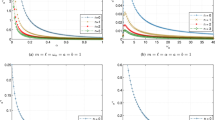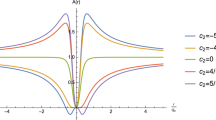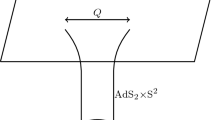Abstract
We analyze noncommutative deformations of a higher dimensional anti-de Sitter-Einstein-Born-Infeld black hole. Two models based on noncommutative inspired distributions of mass and charge are discussed and their thermodynamical properties such as the equation of state are explicitly calculated. In the (3 + 1)-dimensional case the Gibbs energy function of each model is used to discuss the presence of phase transitions.








Similar content being viewed by others
References
Smailagic, A., Spallucci, E.: J. Phys. A36, L517 (2003). https://doi.org/10.1088/0305-4470/36/39/103
Smailagic, A., Spallucci, E.: J. Phys. A37, 1 (2004). https://doi.org/10.1088/0305-4470/37/28/008
Banerjee, R., Gangopadhyay, S., Modak, S.K.: Phys. Lett. B686, 181 (2010). https://doi.org/10.1016/j.physletb.2010.02.034
Nicolini, P., Smailagic, A., Spallucci, E.: Phys. Lett. B632, 547 (2006). https://doi.org/10.1016/j.physletb.2005.11.004
Nicolini, P.: Int. J. Mod. Phys. A24, 1229 (2009). https://doi.org/10.1142/S0217751X09043353
Ansoldi, S., Nicolini, P., Smailagic, A., Spallucci, E.: Phys. Lett. B645, 261 (2007). https://doi.org/10.1016/j.physletb.2006.12.020
Spallucci, E., Smailagic, A., Nicolini, P.: Phys. Lett. B670, 449 (2009). https://doi.org/10.1016/j.physletb.2008.11.030
Tejeiro, J.M., Larranaga, A.: Pramana 78, 155 (2012). https://doi.org/10.1007/s12043-011-0206-0
Liang, J., Liu, B.: Europhys. Lett. 100, 30001 (2012). https://doi.org/10.1209/0295-5075/100/30001
Rahaman, F., Kuhfittig, P.K.F., Bhui, B.C., Rahaman, M., Ray, S., Mondal, U.F.: Phys. Rev. D87(8), 084014 (2013). https://doi.org/10.1103/PhysRevD.87.084014
González, A., Linares, R., Maceda, M., Sánchez-Santos, O.: Phys. Rev. D90(12), 124085 (2014). https://doi.org/10.1103/PhysRevD.90.124085
Ansoldi, S.: In: Conference on Black Holes and Naked Singularities Milan, Italy, May 10–12, 2007 (2008)
Rizzo, T.G.: JHEP 06, 079 (2005). https://doi.org/10.1088/1126-6708/2005/06/079
Born, M.: Proc. Roy. Soc. Lond. A143, 410 (1934)
Born, M., Infeld, L.: Proc. Roy. Soc. Lond. A144, 425 (1934)
Fradkin, E., Tseytlin, A.A.: Phys. Lett. B163, 123 (1985). https://doi.org/10.1016/0370-2693(85)90205-9
Leigh, R.G.: Mod. Phys. Lett. A4, 2767 (1989). https://doi.org/10.1142/S0217732389003099
Wiltshire, D.L.: Phys. Rev. D38, 2445 (1988). https://doi.org/10.1103/PhysRevD.38.2445
Rasheed, D.A.: DAMTP-r-97-08 (1997)
Tseytlin, A.A.: In: The Many Faces of the Superworld (World Scientific, 2000), p. 417
Tamaki, T., Torii, T.: Phys. Rev. D62, 061501 (2000). https://doi.org/10.1103/PhysRevD.62.061501
Gibbons, G.W.: Rev. Mex. Fis. 49S1, 19 (2003). [,324(2001)]
Breton, N.: Phys. Rev. D67, 124004 (2003). https://doi.org/10.1103/PhysRevD.67.124004
Aiello, M., Ferraro, R., Giribet, G.: Phys. Rev. D70, 104014 (2004). https://doi.org/10.1103/PhysRevD.70.104014
Cataldo, M., Garcia, A.: Phys. Lett. B456, 28 (1999). https://doi.org/10.1016/S0370-2693(99)00441-4
Fernando, S., Krug, D.: Gen. Relativ. Gravit. 35, 129 (2003). https://doi.org/10.1023/A:1021315214180
Cai, R.G., Pang, D.W., Wang, A.: Phys. Rev. D70, 124034 (2004). https://doi.org/10.1103/PhysRevD.70.124034
Dey, T.K.: Phys. Lett. B595, 484 (2004). https://doi.org/10.1016/j.physletb.2004.06.047
García, A., Salazar, H., Plebański, J.F.: Il Nuovo Cimento B (1971-1996) 84(1), 65 (2007). https://doi.org/10.1007/BF02721649
Demianski, M.: Found. Phys. 16, 187 (1986). https://doi.org/10.1007/BF01889380
Dvali, G., Gomez, C., Mukhanov, S.: JHEP 02, 012 (2011). https://doi.org/10.1007/JHEP02(2011)012
Spallucci, E., Smailagic, A. In: Barton, A. (ed.): Advances in Black Holes Research. Nova Science Publishers, NY, USA (2014)
Gunasekaran, S., Mann, R.B., Kubiznak, D.: JHEP 11, 110 (2012). https://doi.org/10.1007/JHEP11(2012)110
Akmansoy, P.N., Medeiros, L.G.: arXiv:1712.05486 [hep-th] (2017)
Brown, J.D., Creighton, J., Mann, R.B.: Phys. Rev. D50, 6394 (1994). https://doi.org/10.1103/PhysRevD.50.6394
Nicolini, P., Torrieri, G.: JHEP 08, 097 (2011). https://doi.org/10.1007/JHEP08(2011)097
Banerjee, R., Roychowdhury, D.: Phys. Rev. D85, 044040 (2012). https://doi.org/10.1103/PhysRevD.85.044040
Banerjee, R., Roychowdhury, D.: Phys. Rev. D85, 104043 (2012). https://doi.org/10.1103/PhysRevD.85.104043
Cirilo Lombardo, D.J.: Gen. Rel. Grav. 37, 847 (2005). https://doi.org/10.1007/s10714-005-0071-6
In: Abramowitz, M., Stegun, I.A. (eds.): Handbook of Mathematical Functions with Formulas, Graphs, and Mathematical Tables. Dover Publications, New York (1965)
Acknowledgements
The authors would like to thank the referee for her/his valuable comments and suggestions. This research was supported by CONACyT-DFG Collaboration Grant 147492 “Noncommutative Models in Physics”. The work of A. G. was supported by the Ph.D. scholarship program of the Universidad Autónoma Metropolitana. R. L. acknowledges partial support from CONACyT Grant 237351 “Implicaciones físicas de la estructura del espacio-tiempo”. O. S.-S. was supported by a Posdoctoral Fellowship Grant PROMEP/103.5/13/9043.
Author information
Authors and Affiliations
Corresponding author
Appendices
Appendix A: Calculation of the Temperature
Here we derive a expression for the temperature of the modified black hole in (3+1)-dimensions used in the main text; its generalisation to higher dimensions is straightforward. The metric is assumed to be
with N(r) = f(r). Then the temperature at r = R is [35]
Let us assume that
where W and V are arbitrary functions of their arguments. Then the condition N2(r H ) = 0 implies
In consequence
On the other hand, we have
and evaluation at r = r H gives
It follows that
This expression was used to obtain (55) in the main text.
Appendix B: Integrals for Small Noncommutative Corrections
The quantitiy I1 in the main text is defined by the integral
For I1 it suffices to set H = Q due to the presence of the exponentially decaying ρ Q ; then
Let us perform the change of variable u = s2/4𝜃, then
Using now the asymptotic behaviour for the upper incomplete gamma function [40]
we have
We now evaluate
for small values of 𝜃. In this case we use
valid for small values of 𝜃. We have then
In the above expression, the first integral is nothing but the standard BI electromagnetic contribution to the metric. The second and third integral correspond to exponentially decaying noncommutative corrections and can be evaluated in the same fashion as I1 with the final result
Appendix C: Limit r → 0
We consider the case of (d + 1)-dimensions. Using the fact that [40]
the function H(r) is approximated for small values of r as
where … denotes terms with higher powers of r. Direct substitution of this expression into the equation of motion given by (36) leads to
where … denotes terms with higher powers of r. Integration of this expression gives
where b0 is a constant that can be set equal to − 2M. Therefore
We see that the singularity due to the electromagnetic field has been smoothed out.
Rights and permissions
About this article
Cite this article
González, A., Linares, R., Maceda, M. et al. Thermodynamics of a Higher Dimensional Noncommutative Inspired Anti-de Sitter-Einstein-Born-Infeld Black Hole. Int J Theor Phys 57, 2041–2063 (2018). https://doi.org/10.1007/s10773-018-3730-6
Received:
Accepted:
Published:
Issue Date:
DOI: https://doi.org/10.1007/s10773-018-3730-6




